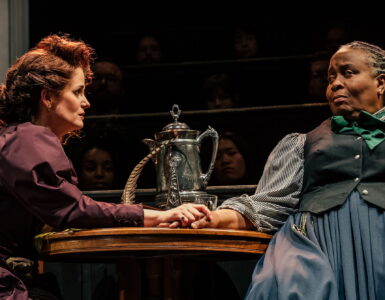Grace Jones: Bloodlight and Bami is a fascinating documentary about a consummate performer with an idiosyncratic personality.
Statuesque, with a naturally superb physique and dramatic bone structure, the Jamaican-born musician, singer, model and performer Grace Jones is one-of-a-kind. She’s reigned as a disco/pop icon for decades.
Not quite 70 and still touring, Jones brings a stylised theatricality to her concerts. She even – seemingly effortlessly – executes a 20-minute hula hoop routine while singing and introducing her band members.
Director and editor Sophie Fiennes takes a “fly on the wall” approach, crafting a beautiful and intimate documentary experience. We are invited into Grace Jones’ world, privy to her daily life and career, even interacting with family members in her island homeland. We see all facets of Jones, from dramatic performer to savvy business person. We see her frustrations and joys as her self-financed, self-produced album takes shape. Maintaining a skipping pace, Fiennes deftly switches from personal conversations to scenes such as Jones laying down vocal tracks in the studio then jumping to magnificent song performances in the vividly filmed concert settings.
All interviews were shot on mini-dv tapes, with Sophie Fiennes recording sound as well. Film was used for the concerts to lend a more lush look and capture the stylistic grandeur of the pop star in action. The sound quality is excellent; Jones is always surrounded by incredibly talented musicians and back-up singers.
Fiennes takes an old-school approach to her subject, one that she has described as “being in the moment”, of observing rather than commenting or overtly shaping the narrative. Only occasionally does the subject appear to be responding to an off-camera (unheard) question, such as when Jones describes the disco era as resembling, for some, “going to church.”
We frequently see Jones’ commanding the situation and competently calling the shots, such as when she berates musician Robbie Shakespeare over the phone for “giving her the run around.” Ever the chameleon, Jones glides from thick Jamaican patois to fluent French at will. A revealing and magnificent sequence is when Jones walks onto the set of a French television show, fully prepared and in full costume, to rehearse a lip-synching number (the disco hit “La Vie en Rose”). Her dismay at being surrounded by sexy lingerie-clad female dancers is expressed to the producer after the camera rehearsal. “I wish you’d shown me a photo of the set-up,” she laments. “It’s like I am a lesbian madam in a brothel! That’s not who I am.” It’s not clear what happens next. Above all, it’s refreshing to see a decisive woman kicking arse and pushing back with necessary toughness when insisting that all those around her match her professional demeanour.
Swimming in a local waterhole we gain a rare glimpse of Jones with short dreadlocks – commonly covered with wigs, hats or scarves. She seems so comfortable in her skin that nudity is never an issue, both on stage and briefly in the doco.
We learn about her strict religious upbringing – beatings at the hands of her step-grandfather while being forced to recite bible verses. She acknowledges that she often channels “Mas P” – her violent step-grandfather – when exhibiting her powerful stage persona.
Approaching 70, Grace Jones is in fine mettle and not showing any signs of slowing down.







